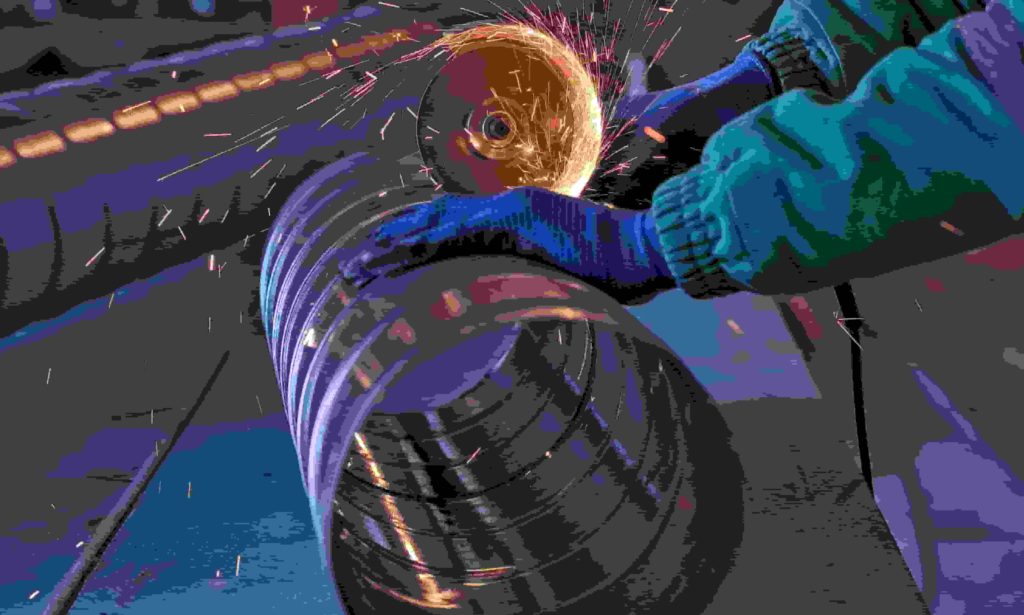Transverse wave motion occurs when all points on a wave oscillate along trajectories that are perpendicular to the wave’s advanced direction. Transverse waves include water surface ripples, seismic S (secondary) waves, and electromagnetic (e.g., radio and light) waves.
Transverse waves oscillate in a direction that is perpendicular to the motion. Light and, to a basic approximation, ocean waves are common examples of transverse waves.
In order to convey their energy, transverse waves require a somewhat stiff medium.
Particles are moved perpendicular to the wave’s travel direction. Vibrations on a string and ripples on the water’s surface are examples of transverse waves. By vertically moving the slinky up and down, we may create a horizontal transverse wave.
The equation v = fλ describes the propagation speed of a transverse wave and is called the transverse wave equation. The wave’s motion is perpendicular to the direction of energy transmission.
In the above equation, f is the frequency of the wave and λ is the wavelength.
Table of Contents
Daily Life Examples of Transverse Waves
Transverse waves are a common occurrence in our daily lives. Here are some examples:
- Light waves: Light waves are transverse waves that travel through the air or vacuum. They enable us to see objects and are used in various technologies like cameras, televisions, and computer monitors.
- Water waves: Waves on the surface of the water are transverse waves. When a pebble is thrown into a pond, it creates ripples that spread outwards as transverse waves.
- Radio waves: Radio waves are transverse waves that are used for communication. They are used in technologies such as cell phones, Wi-Fi, and television broadcasts.
- Guitar strings: When a guitar string is plucked, it vibrates back and forth, creating transverse waves that travel along the string and produce sound.
- Seismic waves: Seismic waves are transverse waves that travel through the earth’s crust during an earthquake. These waves can cause buildings and other structures to shake.
- String instruments: Instruments such as violins, cellos, and harps use strings that vibrate to produce sound as transverse waves.
Transverse Waves Important Points
| Transverse Waves | Description |
|---|---|
| Definition | Waves where the particles in the medium move perpendicular to the direction of the wave’s motion |
| Example | Light waves, waves on a string |
| Motion | The wave travels horizontally while particles of the medium move up and down, oscillating perpendicular to the direction of the wave’s motion |
| Characteristics | Can be polarized, meaning that the particles move only in one direction perpendicular to the wave’s motion |
| Applications | Used in communication technologies like fibre optic cables, as well as in musical instruments like guitars and pianos |
| Related Formulas | The speed of a transverse wave can be calculated using the formula: v = f λ, where v is the speed of the wave, f is the frequency, and λ is the wavelength. The amplitude of a transverse wave can be calculated using the formula: A = (1/2) (y_max – y_min), where A is the amplitude and y_max and y_min are the maximum and minimum displacement of the particles from their resting position. |
Properties of Transverse Waves
Transverse waves have several properties that are important to understand. Here are some of the key properties of transverse waves:
- Amplitude: The amplitude of a transverse wave is the maximum displacement of the particles in the medium from their resting position. This is usually measured in meters or centimetres.
- Wavelength: The wavelength of a transverse wave is the distance between two adjacent peaks or troughs of the wave. This is usually measured in meters or centimetres.
- Frequency: The frequency of a transverse wave is the number of complete oscillations the wave makes in one second. This is usually measured in hertz (Hz).
- Speed: The speed of a transverse wave is the distance the wave travels per unit of time. This is usually measured in meters per second (m/s).
- Polarization: Transverse waves can be polarized, meaning that the particles in the medium vibrate only in one direction perpendicular to the direction of the wave’s motion.
- Reflection: Transverse waves can reflect off of surfaces, such as mirrors, and change direction.
- Refraction: Transverse waves can also refract, or bend, when they pass through different media, such as light waves passing through a prism.
Summary
- Transverse waves are a type of wave where particles of the medium move perpendicular to the direction of the wave’s motion.
- Properties of transverse waves include amplitude, wavelength, frequency, speed, polarization, reflection, and refraction.
- Examples of transverse waves include light waves and electromagnetic waves.
- Transverse waves are important in many areas of science and technology, including optics, electronics, and communication.
Multiple Choice Questions
- Which of the following best describes a transverse wave?
a) A wave where particles of the medium move parallel to the direction of the wave’s motion
b) A wave where particles of the medium move perpendicular to the direction of the wave’s motion
c) A wave where particles of the medium do not move at all
d) A wave where particles of the medium move in a circular motion
Answer: b)
- Which of the following is a characteristic of transverse waves?
a) They can only travel through solids
b) They cannot be polarized
c) They cannot be reflected
d) They can refract when they pass through different media
Answer: d)
- What is the formula for the speed of a transverse wave?
a) v = fλ
b) v = f/T
c) v = d/t
d) v = mgh
Answer: a)
- Which of the following is an example of a transverse wave?
a) Sound waves
b) Water waves
c) Longitudinal waves on a spring
d) Light waves
Answer: d) Light waves
- What is the polarization of a transverse wave?
a) The angle between the direction of the wave’s motion and the direction of particle vibration
b) The ability of the wave to reflect off of surfaces
c) The ability of the wave to refract when it passes through different media
d) The particles in the medium vibrate only in one direction perpendicular to the direction of the wave’s motion
Answer: d)
More Links
- BCl3 Lewis Structure in four simple steps - November 1, 2023
- PH3 Lewis Structure in four simple steps - October 8, 2023
- PF3 Lewis structure in four simple steps - September 24, 2023



